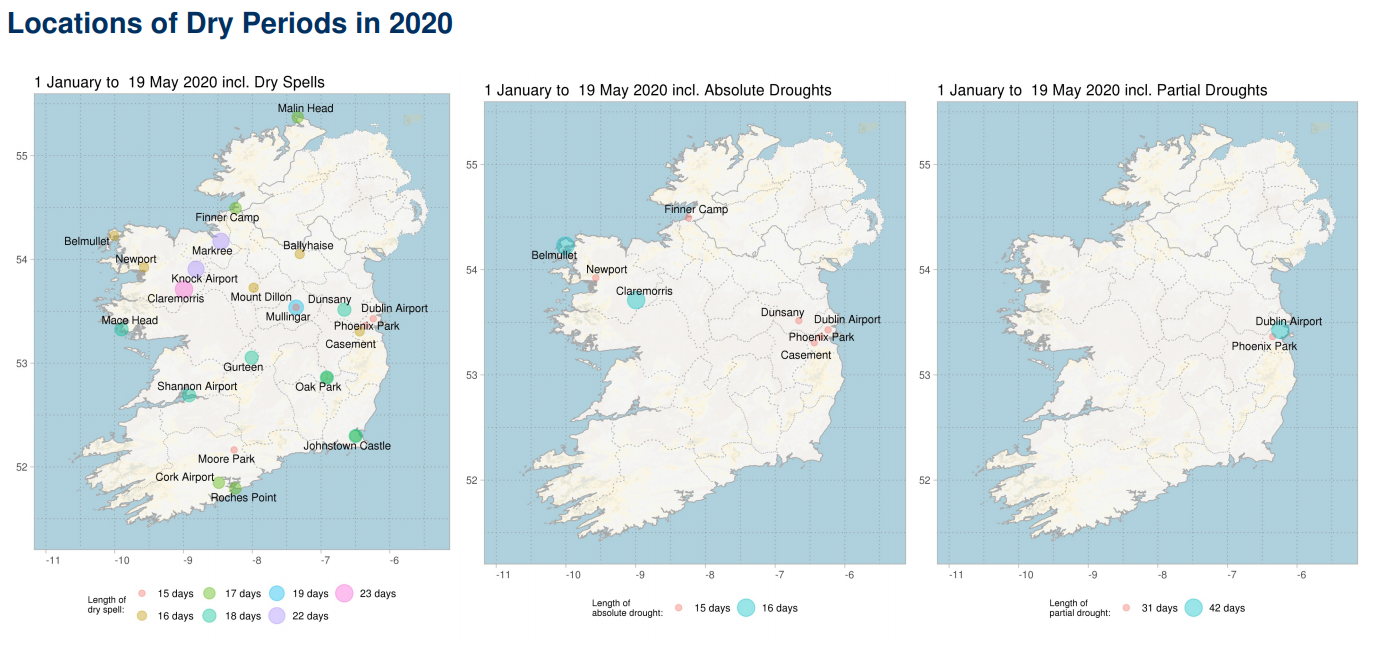Provisional Past Weather and Climate of Ireland
Last updated Wednesday, 20 May 2020 at 13:26 UTC | 14:26 IST
Both droughts and floods are related to extremes rainfall accumulations, but also to other atmospheric and surface conditions. Their impacts are on the natural physical environment. Climatological dry periods are classified as dry spells, absolute droughts and partial droughts. The definitions of which depend on the spell duration and deficiencies in the total daily amounts of rainfall. An absolute drought is often part of a more extensive dry spell and in prolonged droughts, two or all three categories may overlap and in some cases coincide. Dry periods can occur any time of the year, high air temperatures are not necessary. Indeed, winter deficiencies can impact water resources during the following summer. The digital record in the National Climate Archive at Met Éireann contains the nation’s meteorological observations. From this, analysis of the climatological dry periods in Ireland can be determined using daily rainfall accumulations from the synoptic stations. The first occurrence of a dry period in the digital record is 16 days long at Shannon Airport, Co Clare from Wednesday 1 January 1941 to Thursday 16 January 1941 . This report details the occurrences of dry periods in 2020 together with some climatological context and further details of other droughts identified by searching the digital record of rainfall observations in the National Climate Database held at Met Éireann.
There were 37 dry periods in Ireland during 2020, between Wednesday 18 March 2020 and yesterday. Of these 27 were dry spells at 22 stations, eight were absolute droughts at eight stations and two were partial droughts at two stations. The highest number of dry periods occurred at Dublin Airport, Co Dublin with four dry periods (one absolute drought, two dry spells and one partial drought), Phoenix Park, Co Dublin with three dry periods (one absolute drought, one dry spell and one partial drought) , Dunsany, Co Meath with three dry periods (one absolute drought and two dry spells).
See Tables 1, 2 and 3 below for details on the dry spells, partial and absolute droughts (respectively), where shaded rows highlight if a dry period commenced in the current month.
The two instances of dry spells at Dublin Airport in March and April 2020 were broken only by a daily rainfall total of 1.6 mm on the day between them, that is on Thursday 2 April 2020 – which broke the absolute drought at that station, but not enough to break the partial drought. Dry spells at three stations in County Cork lasted 17 days from Thursday 19 March to Saturday 4 April 2020.
By the end of the day on Tuesday 28 April 2020, there were seven ongoing dry spells in counties Mayo, Sligo, Galway, Donegal and Roscommon – the highest period total was 2.2 mm of rainfall with 23 days at Claremorris, Co Mayo (one day from breaking its longest dry spell); two absolute droughts in County Mayo at Claremorris (0.2 mm total rainfall) and Belmullet (0.1 mm total rainfall); while Dublin Airport was at 42 days of a partial drought (4.8 mm total rainfall). During Wednesday 29 April 2020, two bands of rain crossed north-eastward over the country, breaking all these dry spells, absolute and partial droughts. The highest daily rainfall at Claremorris during Wednesday was 10.6 mm, Dublin Airport observed only 4.1 mm and Belmullet measured 7.7 mm.
Full report <<here>>
